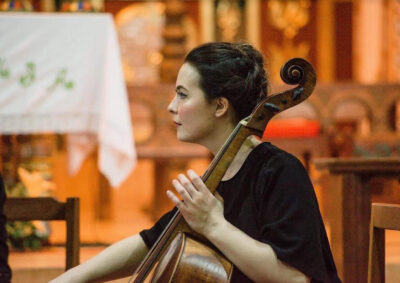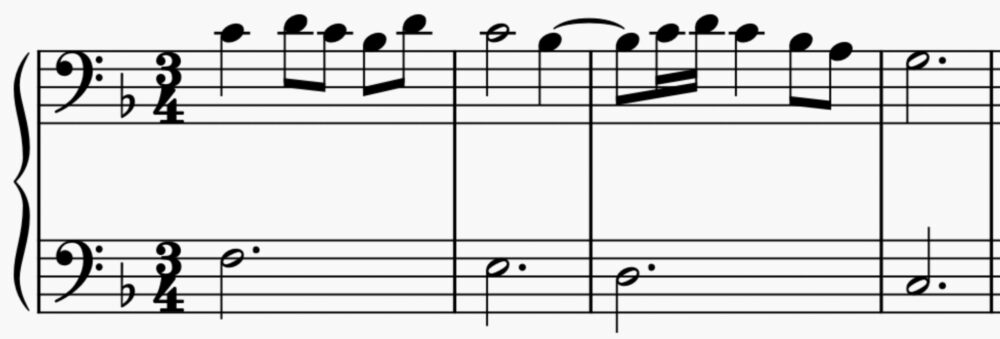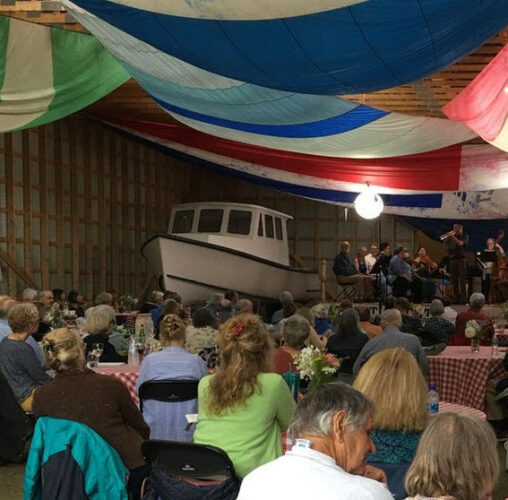by Jacob Jahiel
Published November 21, 2022
A cellist is crafting her own cello suites from borrowed material.

‘If we really want to immerse ourselves in historically informed performance practice, then we acknowledge that they were all performing and composing.’
On today’s classical music scene, composers write music and instrumentalists and singers perform it. In conservatories, the parties go about their work in entirely different departments.
Yet not so long ago, like in the Renaissance and Baroque eras, there was a fluid border between composing, borrowing, improvising, and performing.
Seattle-born, Montréal-based baroque cellist Jessica Korotkin is part of a growing number of performer-composers, resurrecting all the good old ways. Combining historical scholarship with her own ingenuity, she has created a set of Bach-inspired suites for unaccompanied cello, a project she titled Creating New Bach: Cello Suites 7-12.
For Korotkin, her undertaking is not just about expanding a repertory. It is about reimagining the sort of musician she wants to be.
“A big reason why I want to do this is that we often neglect the lost art of being the performer-composer. In Bach’s day, every composer performed, and performers composed. In conservatories, everything is very segmented and specialized. But I really do believe that anyone who plays an instrument should also compose.”
Until a few years ago, Korotkin never imagined herself writing music, remarking “I thought you had to have a degree to compose.” But eager to break from the standard Baroque cello repertoire, she began to borrow from her favorite viola da gamba and keyboard pieces to make her own cello arrangements.
The process required her to make tweaks to the original pieces, for instance reworking a harpsichord ornament to be more idiomatic on cello. “Eventually,” she explains, “I took arranging to such a point that it blurred the line between arranging and composing.”
Amidst pandemic-induced isolation, Korotkin felt drawn to Bach’s unaccompanied cello suites, pieces that are satisfying to play without the benefit of collaborators. However, it seemed that everyone around her had already embarked on performances of the suites, and she was eager to take a different tack.
Previously, Korotkin had offhandedly expressed to her Baroque cello teacher, Susie Napper, that she had been experimenting with making Bach-inspired unaccompanied suites fashioned from borrowed musical material. Napper encouraged her to make it the focus of a recital, and the project eventually became the focus of Korotkin’s doctoral dissertation at McGill University.
It may seem daunting to build on some of the most cherished music in the classical repertoire, but Korotkin looks to Bach and his contemporaries for guidance, arguing that the process has vast historical precedence. What she hopes to expand upon is not so much a body of music, but rather a common compositional practice called the parody process.
In essence, the parody process entails using borrowed material to write entirely new compositions. Research and experimentation have allowed her to closely examine the practice, particularly with regard to Bach who used it to write around a quarter of his extant music.
Many details are lost to history. While examples of parody saturate sacred and secular genres from the Renaissance onward, it is not always easy to discern the step-by-step process by which composers and performers might have used it. The parody process today requires a great deal of historical knowledge, but also a willingness to fill in the gaps.
A handy analogy might be found in something like computer programming. Imagine that, in about three hundred years, a programmer discovers a piece of code from the year 2022. This hypothetical record contains only two pieces of information; an input value ‘a’ and an output value ‘b’. The exact details of the process used to determine ‘b’ are irrecoverably lost, but after rigorous research about programming language from the dawn of the computer age, the programmer can write her own piece of code that produces comparable results.
The 24th-century code will not be identical to its 21st-century counterpart. Computers have made it a long way in three hundred years, and the future programmer conceives of her technology in an entirely different way. In the end, the new process offers a window to the past, but also contains the programmer’s own original and contemporary thought process.
Korotkin admits that, by necessity, her project contains a lot of herself in it. “I think it’s good to make it clear that this is not a reconstruction,” she says. “It’s just taking Bach as inspiration into the modern sphere.”
Informed by what she can piece together from Bach’s process, Korotkin has perfected her own five-step method for creating a new suite.
First, she chooses a suite to imitate. For the purposes of her own project, each of her suites corresponds with one of Bach’s. Thus, Bach’s Suite No. 1 serves as the basis for her Suite No. 7, his second inspires her No. 8, and so on.
Here, for instance, she has transcribed the opening bars from the first minuet of Bach’s Suite No. 2 in D minor, adding a bass line to determine the implied harmonies:

Second, she writes the original suite out in its relative major or minor key, which will also serve as the key for her own movement. Third, she finds a melody to parody, for example drawing from a favorite Bach cantata or instrumental piece. Each Bach suite consists of six dance movements, so the borrowed material should generally match the meter and form of each dance. For her own minuet, Korotkin steals a melody from Bach’s cantata, Höchsterwünschtes Freudenfest (BWV 194), found in the aria, “O wie wohl ist uns geschehen”:

Fourth, she builds upon ideas in the borrowed melody, using the structure and form of the dance movement to organize the new material. Finally, she “plays with the rules,” ensuring the new creation makes sense on her instrument and sufficiently expresses each harmony. On paper, the final product resembles the original melody. But upon hearing, its unfamiliar context transforms it into something new:

For those who might benefit from a demonstration, Korotkin showcases the same passage in a short video produced by Montréal Baroque, where she explains the process in her own words:
Perceptive listeners might notice that the notated first four-bar phrase differs from the video performance. In contrast to Bach’s now canonized and immutable suites, Korotkin’s process produces extemporaneous, fluid results.
The practice of improvisation, one of the last avenues for extemporaneous composition, still thrives among church organists, where vamping to fill time in the service (among other uses) is a key component of the job. But in the concert hall, improvisation seems to represent an atrophied muscle relegated to either very old or very new music.
And that is the point. By reopening the book on Baroque music, Korotkin poses a challenge to the way in which we conceive of composers and their works. Bach is one of her favorite composers, but she sees the demystification of his compositional process as a necessary step in empowering other musicians to emulate it.
“We revere people like Bach and Mozart. We say ‘well, if you can’t compose in a way that says more than what they can say, why bother at all?’ And I think that’s another reason why there is so little representation of marginalized people, like women, in composition, because we have a very specific view of what a composer looks like. There are just other ways to approach that.”
In recent years, Korotkin has presented her research at McGill University, the University of Toronto, Carleton University, and the University of Ottawa. While she intends to submit her dissertation this year, the milestone will hardly mark an end to her work.
“My hope for this is to publish the suites so that other people can play them. Then I want to write an actual method book on how to do something like this so many other people can make their own projects. I think that we need to get out of the mindset that the composer is a god, is the genius. Composing is something that we can all do and should all do. If we really want to immerse ourselves in historically informed performance practice, then we acknowledge that they all were performing and composing. It was all one thing for them.”
Jacob Jahiel is a writer and violist da gamba residing in Montréal. He was a 2022 Rubin Institute for Music Criticism Fellow and is a recent graduate of the Jacobs School of Music at Indiana University, where he obtained an M.A. in musicology with an outside field in historical performance.




